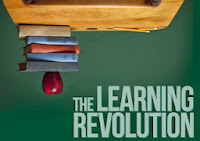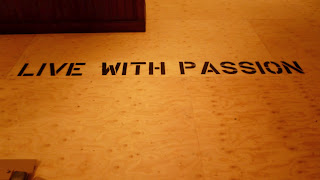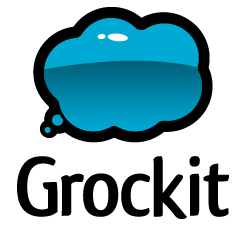Friday, March 28, 2014
Project #15
This project is another individual lesson plan based on the subject of health. It is a lesson plan specifically designed for third or fourth graders. It lasts up to two days, but can last up to three days if you need it to. The class is taught all about the food pyramid and the simple fact that humans need nutrients for the body. This lesson plan is great to instill in young kids so they can maintain a healthy lifestyle! To view the lesson plan, you can go to my Google site.
Wednesday, March 26, 2014
Tuesday, March 25, 2014
Blog Post #10
Sir Ken Robinson's lecture, Bring On the Learning Revolution!, was absolutely engaging, extremely relatable, and funny. However, most importantly informational. He makes very valid points toward education in today's generation. Robinson states in his lecture that education should be changed. In order to do that, normally we would change it or fix what is wrong. However, in Bring On the Learning Revolution, the better solution would be to start new again. This brings the solution to a revolution for education. Robinson uses the saying,"rise with it not to it", which I love. It shows that you must start anew and act anew, by creating new ways for education.
One of the most important things I took from Sir Ken Robinson's speech was how the world sees education. For example, everyone graduates college in four years. I personally can relate to that because everyone learns differently. Which can lead to being a little behind others or more ahead than some peers. Society needs to know that it is okay to not be on a strict schedule when trying to complete school. You can get a degree right out of high school, or 20 years later. Human flourishing is not a mechanical process. You cannot predict the outcome of human development. Also, timing should not matter because as Robinson says,"a three-year old is not half of a six-year old". A three-year old is a three-year old, someone who may or not know things depending on what they have come across since entering the world. Once again, everyone learns everything differently and definitely at their own pace.
Sir Robinson's states the perfect example for how our generation is so technological. He asks the audience who all is over and under the age of twenty-five. After that, he asks, out of the above twenty-five year old age group, who is wearing a wristwatch. Someone who was over the age of twenty-five in the year 2010 was not born in such a technology savvy generation. Therefore, they have never depended on their phone for time. Those people depend on their wristwatch. Robinson has a twenty year old daughter and she stated to him that she does not need a watch due to the fact that it only does one thing. This is a prime example why our generation today is advanced in technology. Next, he talks about passion. He defines passion as something that excites our soul and that it is different in every person. Passion is when you enjoy something so much that an hour feels like five minutes. It is doing what you love. I love that Robinson mentioned that into his lecture because it is important to try and do what you love with your life.
Robinson's speech made a huge impact on me. I have never been able to relate so much with a lecture that we have been assigned to. There is nothing more rewarding than being able to connect with a speaker like that, and then being able to learn so much from it. I will carry what I have learned from Sir Ken Robinson's lecture into my teaching days and make sure to incorporate them into every day life and to always remember to keep my passion in mind.
Saturday, March 22, 2014
Blog Post #9
In the first video with Mrs. Cassidy, She talks about many different things. Mrs. Kathy Cassidy is a 1st grade teacher and firmly believes that technology is an important factor within the classroom. Although her administrative staff doesn't discourage or encourage her directly, the parents of her student's find the technology a positive thing in the classroom. It allows for an audience and for the students to reflect on their own work. Most importantly, parents like the online work so that they are able to see the progress that their own children have made in the class. That is such a huge deal for parents to see their children achieving greatness. Technology is not going to go away. In fact, it will just continue to impact our classrooms more and more as technology progresses. Cassidy says kids and technology go hand in hand. So, the first graders sometimes seem to know more about some online programs than most of my peers do. It's amazing how fast they can pick up on online programs and it's because technology is a part of the every day life now.
During the second video, Cassidy makes a very good point of how to begin using technology in the classroom. It is good to start with what you are most interested in. For example, if you are interested in video you can start with iMovie or YouTube. Another example would be to use Blogger if you're interest is writing for your students. This is a very good place to start with your students. Then, once you start you can progress and add in more programs to your every day lessons. In the last video, she answers questions from John Strange's students. Cassidy informs us about how often she uses blogging. You can use Blogger every day in the classroom, once a week, or even once a month. When using Blogger, you can blog individually or as a group. These are different methods you can use in the classroom to accomplish different academic goals. I thoroughly enjoyed watching the Skype sessions with Mrs. Cassidy and I can definitely say I learned from them. I'm learning so much in this course to use in my future classroom and I can't wait to put all of it into action.
Sunday, March 16, 2014
Project #14
For project #14 we were instructed to create our own individual lesson plans designed for a specific project for the grade we wanna teach. My project is a kindergarden based animal recognition project. This project is over a duration of a week for about 20 minutes a day. It is designed for students to establish and learn shapes and colors that coincide with specific animals. To find my lesson plan, you can visit my Google Site.
Blog Post #8
The first learning and communicating tool I discovered was Edmodo. Edmodo is a online facebook-like environment where classes can connect online. It is very similar to blogger because you can access what other teachers are doing in their classrooms, collaborate on assignments, and discover new resources. Edmodo is used to get students excited about learning and keeping them engaged. Using tools online does help educational purposes more enjoyable for students. Kids these days love Facebook. So why not use a similar technological tool for learning? Technology creates a initiative to learn.
My favorite by far is Grockit. This is a website for online study sessions. On Grockit you can study for your every day class test or even your ACT or SAT. Grockit is most beneficial for college level students. Grockit is convenient, no boring classrooms and lectures! Grockit predicts your score based on your answers and tracks your performances and improvements, projecting accurate score improvements. Grockit study plans provide practice tests, personalized insight into your weak subject areas, review of your work, and the right tutor to help you. This is perfect for any struggling college student, including myself. Which is the most important reason why Grockit is my new favorite learning and communicating tool.
These two tools seemed most important to me because I feel like I would really use them. Finding these was fun because I did not know they even had tools like this. Usually I only hear about tools from my professors, but it was awesome being able to go find them all on my own. Especially to look for ones that I can use in the future or specifically for certain subject while I'm currently enrolled in college courses. It is very rewarding to find and be able to use these today and for the rest of my educational experiences.
C4T #2
The teacher's blog I was chosen to this week was Andrea Hernandez. Her blog Authentic Literature talk about her "parent connect sessions" every month. These sessions are where a small but dedicated group of parents joined us to discuss a variety of topics related to changes in learning and how their school would respond to those changes. Hernandez says that this "promotes initiatives, as that small group of parents acted as ambassadors spreading vital positivity and understanding throughout the parent community." This really opens up a great opportunity to be the best because of the parent's and teacher's opinions.
Andrea Hernandez's next blog, A Teacher's Ode to Read-Alouds. First of all, Hernandez believes that reading aloud is a vital tool for teaching anything and everything about reading. Reading out loud offers great opportunities to discuss vocabulary strategies! Vocabulary strategies used in the classrooms are things like the word wall. The word wall is where student's pick a word from the read aloud, that they might not know, and try to find a synonym of the word that they do know. Reading aloud also gives the opportunity for assignments afterwards, such as written responses and discussion. I loved reading this blog because I have never had this point of view on reading aloud in the classroom. It's a great perspective and has really inspired me to use this in my future classroom. Along with every blog post from Andrea Hernandez, they have all inspired me to use her ideas in my classroom!
Andrea Hernandez's next blog, A Teacher's Ode to Read-Alouds. First of all, Hernandez believes that reading aloud is a vital tool for teaching anything and everything about reading. Reading out loud offers great opportunities to discuss vocabulary strategies! Vocabulary strategies used in the classrooms are things like the word wall. The word wall is where student's pick a word from the read aloud, that they might not know, and try to find a synonym of the word that they do know. Reading aloud also gives the opportunity for assignments afterwards, such as written responses and discussion. I loved reading this blog because I have never had this point of view on reading aloud in the classroom. It's a great perspective and has really inspired me to use this in my future classroom. Along with every blog post from Andrea Hernandez, they have all inspired me to use her ideas in my classroom!
Wednesday, March 12, 2014
Sunday, March 2, 2014
Project #13
My group, San Francisco, created our Lesson Plan #1 on the subject of second grade science. The goal for our lesson plan is to bring forth as much information about the solar system to our students as we can. It is a project designed to last a week with a maximum of two hours a day to work on the assignments. Tasks that are assigned to this project include: physical characteristics of each planet that is assigned to each group, the distance each planet if from each other, and to be able to recreate a 3D model of assigned planet.
Subscribe to:
Comments (Atom)








